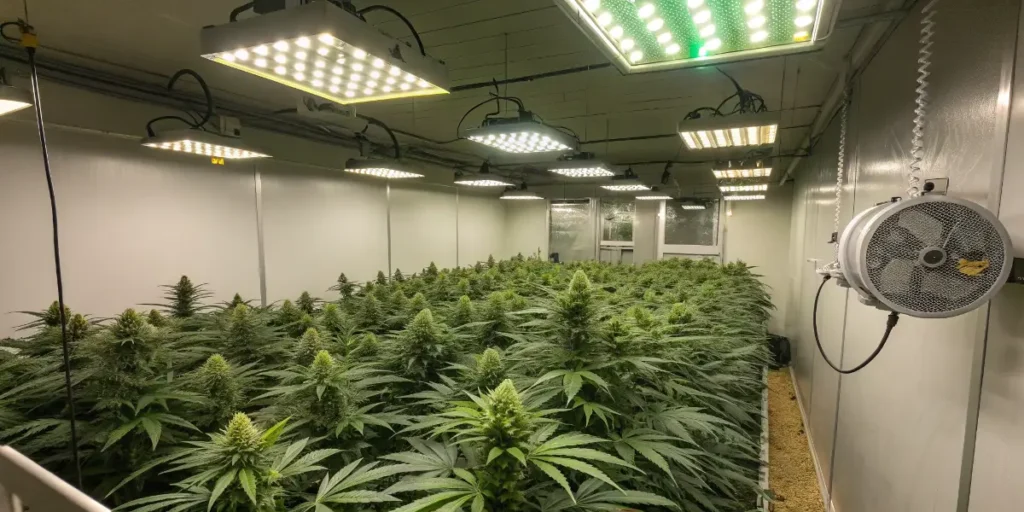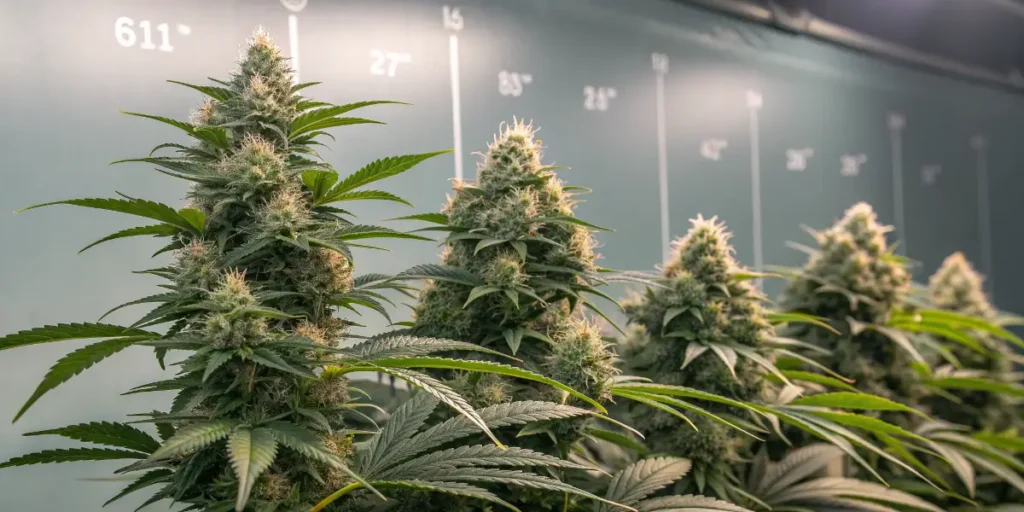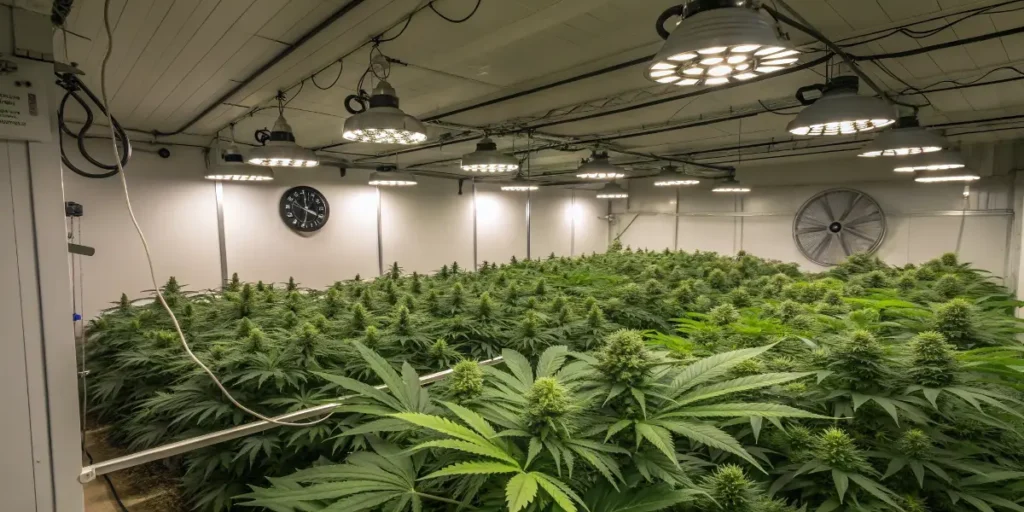Pineapple Dream is a delightful cannabis strain renowned for its fruity aroma and well-balanced effects. For those interested in cultivating this strain, it’s essential to grasp its specific growing needs to ensure a lush and fruitful harvest. This strain thrives in both indoor and outdoor environments, making it a versatile choice for growers of all experience levels. However, like any strain, it requires particular attention to environmental factors, nutrients, and overall care to flourish.
The first step in growing this strain is to choose the right medium. This strain can comfortably grow in either soil or a hydroponic setup. Soil is generally recommended for beginners due to its ability to buffer nutrients and its natural microbial environment, promoting healthy root development. For those opting for hydroponics, ensure you monitor pH and nutrient levels frequently, as the plants will absorb nutrients more directly in this setup.
Lighting is crucial when cultivating this strain indoors. This strain responds well to both LED and HID lights. Make sure to provide at least 18 hours of light during the vegetative stage, which can be reduced to 12 hours once the flowering stage is triggered. The use of reflective materials around the grow space can maximize light exposure, promoting better growth and yield.
This strain prefers temperatures between 70 and 80 degrees Fahrenheit with humidity levels starting at 60% during the vegetative stage, decreasing to around 40% during flowering. Adequate ventilation is also vital to prevent mold and mildew, especially since this strain can be susceptible if conditions are overly humid.
Feeding is another key component in growing Pineapple Dream. Implement a balanced nutrient regimen suited for cannabis, with a focus on nitrogen during the vegetative phase and an increased focus on phosphorus during the flowering phase. Additionally, regular watering is vital, but be cautious of overwatering, which can lead to root rot—ensure the soil or grow medium has suitable drainage.
Pruning and training techniques such as topping and LST (low-stress training) can be beneficial to maximize yields and ensure even light distribution across the plant canopy. By consistently monitoring and adjusting environmental conditions and nutrient levels, you can cultivate a robust and aromatic harvest.
pineapple dream Strain Overview: Traits, Effects & Genetics
The Pineapple Dream strain is a sought-after hybrid known for its balanced effects and unique flavor profile. Originating from skilled cultivation practices, this strain is typically characterized by its vibrant tropical aroma reminiscent of fresh pineapples, combined with subtle earthy undertones. The dense, trichome-coated buds are visually appealing, often exhibiting bright green hues intertwined with orange pistils. Notably, this strain boasts a robust THC content, typically ranging between 18% and 25%, making it particularly appealing to users seeking potent effects. Its balanced combination of indica and sativa genetics allows it to cater to a wide range of cannabis enthusiasts.
This strain’s effects are both cerebral and relaxing, offering a blend that tends to invigorate the mind while soothing the body. Users often report an initial wave of euphoria, followed by a creative surge that can be ideal for artistic endeavors or brainstorming sessions. This cerebral uplift is complemented by a gentle body relaxation, which tends to keep users comfortably grounded. The calming physical sensations make it a suitable choice for stress relief or unwinding after a long day. Despite its potency, this strain usually allows for clear-headedness, making it suitable for daytime and evening use without the risk of overwhelming sedation.
Genetically, this strain is believed to be a cross between Pineapple Express and Blue Dream, two renowned strains celebrated for their unique characteristics and widespread popularity. Pineapple Express contributes to the tropical flavor and invigorating effects, while Blue Dream provides the balance and extensive appeal through its indica-sativa harmony. This genetic blend gifts Pineapple Dream the best of both worlds, resulting in a strain that offers the uplifting and fruity elements of Pineapple Express, tempered with the well-rounded relaxation of Blue Dream. Cultivators appreciate this strain for its resilience and yield potential, making it a reliable choice for both novice and experienced growers.
Overall, this strain stands out as a versatile strain capable of meeting diverse user preferences due to its unique blend of traits, effects, and genetics. Its ability to offer a flavorful experience without sacrificing potency or balance makes it a staple for many cannabis connoisseurs. Whether used for recreational or medicinal purposes, this strain is a testament to the dynamic innovation within the cannabis breeding community.
Optimal Environment to Grow Pineapple Dream Successfully
This strain is known for its tantalizing tropical aroma and relaxing effects. To grow this strain successfully, recognizing its environmental needs is pivotal. Like most cannabis plants, Pineapple Dream thrives in a climate that closely mimics its natural habitat. Ideally, this involves warm temperatures, moderate humidity, and plenty of light. Indoor cultivators should aim to keep the temperature between 70°F and 85°F. Outdoor growers should ensure the climate doesn’t dip below 60°F at night, particularly during the flowering stage.
Humidity plays an essential role in the successful growth of this strain. During the vegetative phase, it’s best to maintain a humidity level between 40-60%. However, as the plant enters the flowering stage, reducing humidity to around 30-40% can help prevent mold growth and ensure robust bud development. Regular monitoring with a reliable hygrometer is recommended to maintain these optimal conditions and make adjustments as necessary.
Lighting is another crucial factor. This plants require abundant light throughout their various growth stages. If growing indoors, consider using high-quality LED grow lights that can provide full-spectrum lighting for ideal growth. The vegetative stage will benefit from 18 hours of light per day, while the flowering stage requires a reduced light period of 12 hours to stimulate bud production. Investing in timers can help maintain these schedules consistently.
Proper ventilation and air circulation are vital components. Stagnant air can lead to pest infestations and mold issues. Employ fans or exhaust systems to ensure constant air movement, particularly in indoor settings. Outdoors, ensuring proper plant spacing can facilitate air circulation and exposure to light, aiding in the overall health and vigor of the Pineapple Dream plants.
Grow Room Setup for Pineapple Dream Plants
Setting up a grow room for this plants involves creating an environment that optimizes their growth and enhances their unique characteristics. Pineapple Dream is known for its tropical aroma and euphoric effects, necessitating a stable and controlled environment to achieve its full potential. Start by selecting a suitable space that ensures discretion, adequate access, and ease of control for temperature and humidity levels. A grow tent or a dedicated room with reflective surfaces is ideal to maximize light efficiency and minimize energy wastage.
Temperature and humidity are critical factors in fostering healthy plants. Aim to maintain a daytime temperature range between 70-85°F (21-29°C) and a nighttime drop to around 60-70°F (15-21°C). These conditions mimic the tropical climates that support explosive growth and abundant resin production. Additionally, control humidity levels closely; this strain requires humidity levels around 40-60% during the vegetative phase, dropping closer to 40% during flowering to prevent mold and mildew.
Lighting is another essential component of the grow room setup. This plants thrive under bright, consistent lighting. LED grow lights provide an energy-efficient solution that delivers the full spectrum needed for robust plant growth. Install lights that can be easily adjusted to maintain a distance of about 12-24 inches from the canopy, depending on the plant’s growth phase, ensuring adequate light penetration without causing heat stress.
An effective ventilation system is vital for maintaining air circulation and removing excess heat and moisture. Utilize oscillating fans to promote airflow across the plants, preventing stagnant air zones that can lead to pest and disease issues. An exhaust fan with a carbon filter helps eliminate plant odors and regulate temperature. This setup will ensure the air remains fresh and CO2 levels are adequate for photosynthesis.
Consider the grow medium and nutrient setup. This plants can be grown in soil or hydroponically. For soil, use a high-quality organic mix enriched with essential nutrients. For hydroponic systems, ensure a balanced nutrient solution tailored for cannabis to promote vibrant growth. Regularly monitor pH levels and nutrient concentrations to head off potential growth issues early, thus offering Pineapple Dream the best environment to thrive.
Indoor Growing Tips for Pineapple Dream
Pineapple Dream is a popular cannabis strain known for its sweet tropical aroma and euphoric effects. When growing this strain indoors, it is vital to start with quality seeds or clones from a reputable source to ensure a successful yield. This strain thrives in a controlled environment that mimics its natural tropical habitat, so investing in an adjustable indoor grow setup is crucial for promoting healthy plant development. Ensure your grow area has adequate space for the plants to expand, as this strain tends to grow tall and bushy.
Lighting is a pivotal factor in the successful cultivation of this strain indoors. It requires intense light during the vegetative and flowering stages to maximize bud production and potency. Full-spectrum LED grow lights are highly recommended, as they mimic natural sunlight and consume less electricity. Ensure the lights are positioned approximately 18-24 inches above the plant canopy to promote healthy growth without causing light burn. Adjust the light schedule to support an 18/6 cycle (18 hours of light, 6 hours of darkness) during the vegetative stage and change it to a 12/12 cycle for flowering.
Temperature and humidity control are essential for growing Pineapple Dream indoors. Aim for a temperature range between 70-85°F (21-29°C) with the humidity level maintained around 40-60% during the vegetative stage. During flowering, reduce humidity to 40-50% to prevent mold and mildew. Using fans and ventilation systems helps regulate these parameters, ensuring air circulation and preventing heat buildup around the plants. Regularly monitor these levels using thermometers and hygrometers to adjust the conditions as necessary for optimal growth.
The soil medium plays a crucial role in the overall health of this plants. An organic, well-draining soil rich in nutrients is ideal for promoting robust growth and potent flowers. Incorporate organic amendments such as perlite, vermiculite, or coco coir to enhance aeration and water retention. Pineapple Dream’s nutritional needs are best met through a balanced feeding schedule, with higher levels of nitrogen during the vegetative phase and an increase in phosphorus and potassium during flowering. Consistent watering while avoiding over-saturation encourages healthy root systems.
Pruning and training techniques can enhance the yield and quality of Pineapple Dream grown indoors. Regularly trimming foliage allows for better light penetration and airflow within the canopy, reducing the risk of mold and pests. Techniques such as topping, low-stress training (LST), or the Screen of Green (ScrOG) method are beneficial for optimizing space and increasing bud size. With patience and proper care, this strain can produce a bountiful indoor harvest of fragrant, high-quality buds ready for distribution or personal use.
Outdoor Growing Tips for Pineapple Dream
Pineapple Dream is a popular cannabis strain known for its tropical aroma and uplifting effects. When considering outdoor cultivation of this strain, several factors contribute to a successful harvest. Location is a crucial consideration; choose a spot that receives ample sunlight for at least six to eight hours a day, as this will encourage vigorous growth and potent buds. Adequate air circulation is also necessary to prevent mold and mildew, so avoid low-lying areas where moisture might accumulate.
Soil preparation is another essential aspect of growing Pineapple Dream outdoors. This strain thrives in well-draining soil enriched with organic matter. Amend your garden plot with compost or well-rotted manure before planting to enhance the soil’s nutrient profile. Additionally, ensure the pH level of the soil ranges between 6.0 and 7.0; this slightly acidic to neutral range facilitates optimal nutrient uptake. Regularly test the soil’s fertility and adjust with appropriate fertilizers to meet this strain’s growth requirements.
This strain is sensitive to temperature and humidity levels. This strain prefers a Mediterranean climate with warm, sunny days and cooler nights. If you reside in an area prone to cold snaps, consider using frost cloths or temporary greenhouses during the early stages of growth to protect young plants. As the plants mature, monitor humidity levels and ensure that air circulation is maintained to prevent mold and pests. Make sure to water consistently but be cautious of overwatering as this can lead to root rot.
Pruning and training techniques can significantly enhance the yield and quality of this plants. Utilize methods such as topping or low-stress training (LST) to promote lateral growth and even light distribution across the plant. This encourages the development of multiple budding sites and ultimately increases yield. Keep an eye out for common outdoor pests such as aphids or spider mites. Employ organic, plant-safe methods for pest control, like neem oil or insecticidal soap, to protect your Pineapple Dream plants without introducing harmful chemicals.
Recognizing the timing of your harvest is crucial. This strain typically flowers between eight to ten weeks, with outdoor harvests peaking in late September to early October depending on local climate conditions. Monitor trichome development closely; a shift from clear to milky white or amber indicates that the plants are ready for harvesting. Proper timing ensures maximum potency and flavor, offering the best representation of the Pineapple Dream’s characteristics. Implement these outdoor growing tips to cultivate a healthy and abundant crop of this strain.

How to Germinate & Propagate Pineapple Dream
Germinating and propagating Pineapple Dream, an exotic cannabis strain known for its tropical aroma and uplifting effects, starts with selecting high-quality seeds from reputable sources. It’s essential to choose fully matured seeds with a consistent brown color and slight sheen, avoiding green or immature seeds. The germination phase is the most critical step, as it lays the groundwork for a healthy plant’s development. The paper towel method is widely recommended for its simplicity and effectiveness.
Begin by placing your seeds between two damp paper towels. The towels should be moist but not overly saturated, as excess water can cause the seeds to rot. Place the towels onto a flat surface, such as a plate, then cover them with another plate to maintain humidity levels. Store the setup in a warm, dark location, ideally with temperatures ranging between 70-85°F (21-29°C). Check the seeds daily and ensure the towels remain moist, adding water as needed.
After 3 to 7 days, you should see small white roots emerging from the seeds, indicating successful germination. Once these roots are about a quarter to half an inch long, the seeds are ready to be transplanted into a growing medium. Many growers prefer to use peat pellets or starter cubes for this stage, as they provide optimal support and nutrients for young seedlings. Gently place each seed into the medium, ensuring the root faces downward, and cover it lightly with the substrate.
For propagation, consider using healthy clippings from a matured plant. Cut a 4 to 6-inch section from a vigorous branch, preferably one with multiple nodes. Remove the leaves from the bottom half and dip the cut end into a rooting hormone to enhance root development. Insert the cutting into a prepared growing medium, like rock wool or perlite, and keep it in a humid environment with indirect light. Regular misting can help maintain humidity levels.
During both germination and propagation, maintaining consistent environmental conditions is crucial for success. Ensure the seedlings and cuttings receive enough light, around 18-24 hours of light per day initially, using grow lights for indoor cultivation. Monitoring root and stem development closely will help address any potential issues early on, thus securing a robust start for your plants, leading to a rewarding growing experience.
Vegetative Stage
The vegetative stage is crucial for the healthy development of your cannabis plants. During this phase, plants focus on growing strong roots, vibrant foliage, and a robust structure to support future flowering. Providing optimal conditions is essential to maximize your plants’ potential. Start by ensuring they receive ample light; ideally, 18-24 hours of light each day using high-quality LED or fluorescent grow lights. Proper lighting encourages photosynthesis, leaves, and stem growth, setting the foundation for a bountiful harvest.
Equally important to light is the nutrient regimen you provide. This plants require a balanced mix of nutrients rich in nitrogen during the vegetative stage. Nitrogen is vital for promoting lush, green foliage and overall plant vigor. Consider using a specialized vegetative plant food that includes other macro and micronutrients like potassium and phosphorus. These elements support robust plant metabolism and development. Always follow the manufacturer’s guidelines to avoid over-fertilization, which can lead to nutrient burn and stress.
Additionally, maintaining ideal environmental conditions is essential. This strain thrives in temperatures ranging between 70-85°F (21-29°C) with relative humidity levels around 40-60%. These conditions help your plants absorb water and nutrients effectively. Ensure proper air circulation within your growing space to prevent mold and mildew, which can hinder growth. Regularly trim and prune your plants to remove dead or overcrowded leaves, which will improve airflow, light penetration, and redirect energy towards new growth.
Another critical aspect of nurturing your Pineapple Dream plants during the vegetative stage is watering practices. Consistency is key, ensuring your plants receive regular, yet not excessive, water to keep the soil evenly moist. Over-watering can lead to root rot and nutrient lockout, while under-watering can cause stress and stunted growth. Monitor the soil moisture level using your fingers or a moisture meter, adjusting as necessary. Additionally, consider using a well-draining soil mix to prevent waterlogged roots.
Be vigilant about potential pests and diseases. Inspect your plants regularly for signs of infestations or disease. Early detection allows for prompt action, preventing further spread. Employ organic pest control methods or integrated pest management (IPM) strategies to maintain a healthy growing environment. Employing beneficial insects like ladybugs can offer a natural way of keeping pest populations in check, creating a healthier ecosystem for your plants.
Flowering Pineapple Dream: What to Expect
The flowering stage of Pineapple Dream is an exciting period for cannabis cultivators as it indicates the culmination of diligent care and attention to detail. Typically, this strain enters the flowering phase after approximately 8 to 9 weeks of vegetative growth. This transition is pivotal, marked by the development of bud sites and a noticeable change in aroma as the plant begins to produce the characteristic sweet, tropical fragrance it is known for. During this time, growers should pay close attention to environmental conditions such as humidity and temperature to ensure optimal bud development and prevent common issues like mold and mildew.
As this strain progresses through flowering, expect to see the formation of dense, resinous buds laden with trichomes. This luxurious coating is a telltale sign of the strain’s high cannabinoid content, especially its THC levels, which are typically elevated in this variety. The buds may exhibit hues ranging from vibrant green to hints of purple, depending on growing conditions and phenotypic expression. Cultivators should consider implementing a nutrient regimen rich in phosphorus and potassium during this stage to support robust bud formation and enhance terpene production, which contributes to the strain’s distinctive pineapple and citrus profile.
Throughout the flowering stage, it is crucial to maintain vigilance against pests and diseases that can impact yield and quality. Regular inspection and the use of preventative measures, such as integrated pest management practices, can mitigate these risks. Growers should also prepare for the eventual harvest by monitoring trichome maturity using a magnifying tool to assess the cloudiness and amber coloration as indicators of peak potency. Successfully managing these aspects during flowering not only enhances the final product’s flavor and aroma but also maximizes the therapeutic potential of Pineapple Dream.
Fertilizers & Nutrient Schedule
Pineapple Dream, a sativa-dominant hybrid renowned for its uplifting and euphoric effects, requires a balanced and strategic feeding schedule to ensure optimal growth and yield. This strain thrives when provided with a nutrient-rich diet that starts with a nitrogen boost during the vegetative stage. It’s essential to understand the plant’s nutritional needs at each growth phase to prevent nutrient burn or deficiency. Begin with a high-quality cannabis-specific fertilizer that provides the essential macronutrients: nitrogen (N), phosphorus (P), and potassium (K), commonly referred to as N-P-K.
During the vegetative stage, which typically lasts 4-8 weeks, Pineapple Dream requires a higher concentration of nitrogen to promote healthy leaf and stem development. Use a fertilizer with an N-P-K ratio such as 3-1-2 or 4-2-3. This ratio supports robust vegetative growth, allowing the plant to build a strong foundation for the flowering stage. Administer nutrients once or twice a week, observing your plants for any signs of nutrient imbalance. Always follow the manufacturer’s dosage recommendations and adjust based on the plant’s response.
As this strain transitions to the flowering stage, which lasts 8-10 weeks, it’s crucial to decrease nitrogen levels while increasing phosphorus and potassium. Switch to a bloom-specific fertilizer with an N-P-K ratio around 1-3-4 or 2-4-5. The elevated phosphorus supports bud formation, while potassium enhances the overall quality and size of the flowers. Continue to feed the plants weekly, and it’s beneficial to flush them with plain water during the final two weeks to remove residual nutrients, improving the taste and smoothness of the final product.
Moreover, micronutrients like calcium, magnesium, and sulfur play a significant role in the healthy development of this strain. These can be supplemented through cal-mag solutions, especially if growing in reverse osmosis (RO) water or coco coir, both of which have tendencies to leach calcium and magnesium. Monitoring the pH level of the water and nutrient solution is crucial, maintaining it between 6.0 and 7.0 for soil, or 5.5 to 6.5 if using hydroponic systems, to ensure nutrient uptake efficiency.
To conclude, successful feeding of this strain involves a careful balance of macro and micronutrients tailored to each growth stage. Paying close attention to the plant’s specific needs and environmental factors will result in a healthy and bountiful harvest. Regular monitoring, adjustments, and care will help you grow potent and flavorful Pineapple Dream cannabis plants.
Pest and Disease Prevention for Healthy Cannabis Plants
Growing this strain, known for its sweet and tangy flavors, requires careful attention to pest and disease prevention to ensure healthy growth and maximum yield. Pest and disease management begins with choosing a clean and sterile environment. Before introducing plants to your growing area, ensure that all tools, containers, and surfaces are thoroughly cleaned and sterilized. This preventive step is crucial for reducing the risk of contamination and establishing a healthy baseline for plant growth.
Once your growing area is prepared, regular monitoring of your cannabis plants is essential. Conduct frequent inspections, looking for early signs of pests such as spider mites, aphids, and whiteflies, which are common cannabis adversaries. Checking the underside of leaves and stems is crucial as many pests tend to hide in these areas. Early detection allows for swift action, minimizing potential damage to your plants.
Natural pest management methods should be your first line of defense. Introducing beneficial insects like ladybugs and predatory mites can naturally keep pest populations under control without resorting to chemical pesticides. These allies in your garden consume harmful pests, providing a balanced ecosystem. Additionally, companion planting with pest-repelling plants like basil, marigold, or mint can deter insects effectively, creating a more harmonious growing environment.
Besides pest control, disease prevention plays a vital role in maintaining healthy Pineapple Dream plants. Ensure proper air circulation by spacing your plants adequately and using fans if necessary. Good airflow reduces humidity and the risk of fungal diseases such as powdery mildew and bud rot. Monitoring and controlling humidity levels, especially during the flowering stage, is critical to preventing these common yet destructive diseases.
Maintaining optimal nutrition and avoiding over-watering are fundamental to disease prevention. Over-watering can lead to root rot, making plants more susceptible to pathogens. Ensure your plants receive the right balance of nutrients and water, promoting strong immune responses against diseases. Regularly check soil moisture levels to avoid water-related issues, thus fostering a thriving and pest-free cannabis garden.

Harvesting & Drying
Properly harvesting and drying your Pineapple Dream cannabis plants is crucial to preserving the distinct aromatic and flavorful qualities that make this strain special. Knowing the right moment to harvest ensures optimal potency and flavor. Typically, this strain reaches peak harvest time when the trichomes on the buds turn milky white with some shifting to an amber hue. Usually, this occurs around eight to ten weeks into the flowering phase, depending on your growing conditions. Careful monitoring of the trichomes using a magnifying glass or jeweler’s loupe is recommended to determine the ideal harvest window.
Once you’ve determined it’s time to harvest, begin by cutting down the branches carefully to preserve the integrity of the buds. Remove larger fan leaves to improve air circulation, which helps in the drying process. Suspend the branches in a well-ventilated space with temperatures kept between 60-70°F (15-21°C) and humidity levels around 45-55%. Maintaining these conditions is essential to prevent mold growth and to enhance the overall drying process. Using string or wire, hang the branches upside down, ensuring they are not crowded, to allow for even drying and to maintain airflow around each plant.
The drying phase for Pineapple Dream should ideally take seven to fourteen days. You will know the drying is complete when smaller stems snap rather than bend, indicating that the moisture content is at a desirable level. Once dried, carefully trim the buds from the branches and prepare them for curing. Place the trimmed buds in airtight glass jars to cure, opening them daily for a few minutes to release any residual moisture; this is known as “burping.” This stage can last between two to three weeks, allowing the buds to fully develop their rich walnut and pineapple flavors, while smoothing out the overall smoke experience.
pineapple dream Strain Type: Indica, Sativa or Hybrid?
The pineapple dream strain is often recognized as a balanced hybrid, exhibiting traits from both Indica and Sativa varieties. This strain stems from a selective breeding process that seeks to blend the best qualities of its parent plants. Typically, hybrids like this strain is purposefully crafted to offer a versatile experience, potentially delivering well-rounded effects that appeal to a broad range of cannabis enthusiasts. The balanced nature allows for flexible use, whether it be for relaxation or creative stimulation, making it a favorite for both recreational and medicinal users alike.
Hybrids such as pineapple dream are known for their ability to provide the perfect equilibrium between cerebral invigoration and physical relaxation. This combination allows users to experience mental clarity and elevated mood while still enjoying the soothing body effects indicative of Indicas. For folks seeking relief from stress or minor aches while still wanting to maintain a level of energetic function, this strain can be ideal. Its balanced genetics ensure that users aren’t overwhelmed by sedation or extreme psychoactivity, making it suitable for various use-cases throughout the day.
The structural characteristics of this strain mirror its hybrid nature, often featuring dense buds that are larger than those of pure Indica strains but not quite as airy as those predominating in Sativas. Additionally, you can expect the sensory experience to reflect its hybrid roots, with a nuanced aroma profile that may chant sweet, fruity notes reminiscent of its namesake fruit, intertwined with earthy undertones. This aromatic blend further compliments its balanced effects, appealing to a wide demographic of cannabis connoisseurs seeking a harmonious, flavorful experience.
Ultimately, as a hybrid, this strain provides the best of both worlds, ensuring a unique cannabis experience. Whether you are seeking therapeutic benefits or simply looking to enhance your recreational ventures, this strain offers an adaptable profile. Its multifaceted nature encourages individuals to experience and enjoy both the cognitive and physical delights typical of hybrids, underlining why it remains a highly regarded choice within cannabis communities. This strain exemplifies why hybrids are indispensable in contemporary cannabis cultivation, offering tailored effects that cater to diverse user preferences and needs.
Key Benefits for Cultivators
This strain is an increasingly popular choice among cannabis cultivators, boasting a myriad of benefits that make it stand out from other strains. One of the primary reasons for its popularity is its unique, enticing aroma and flavor profile. With a sweet, tropical pineapple scent fused with earthy undertones, it offers consumers an enjoyable and memorable experience. This makes Pineapple Dream highly sought-after in both medicinal and recreational markets, providing cultivators with the opportunity to grow a strain that is in constant demand.
Cultivators also appreciate this strain for its robust growth characteristics. This strain is known for its resilience, making it suitable for both novice and experienced growers. It thrives in various environments, including both indoor and outdoor setups, which offers flexibility depending on a grower’s available resources. This strain tends to be a relatively low-maintenance plant, as it is resistant to common pests and diseases, reducing the need for extensive interventions and care. This resilience, combined with its adaptability, leads to a more cost-effective cultivation process.
Beyond its appealing taste and reliable growth patterns, this strain boasts significant therapeutic benefits that make it a favorite in the medicinal cannabis community. The strain is noted for its well-balanced hybrid effects, providing both uplifting cerebral stimulation and soothing physical relaxation. Consumers frequently turn to Pineapple Dream for relief from stress, anxiety, and depression, making it an ideal choice for those seeking a natural remedy for emotional or mental health issues. Its versatility in addressing a wide range of symptoms further enhances its marketability, ensuring that cultivators can consistently find buyers eager for its therapeutic benefits.
Besides its therapeutic advantages, this strain is known for yielding a high THC content, which attracts recreational users seeking a potent experience. Its ability to balance powerful effects with a clear-headed, calming finish ensures a wide consumer base. This broad appeal translates to positive economic potential for growers, as they are cultivating a strain that appeals to both new and seasoned cannabis enthusiasts. Ultimately, the unique profile and benefits of Pineapple Dream solidify its standing as a valuable strain for cultivators looking for a reliable and marketable crop.
Potential Challenges When Growing Pineapple Dream
Growing this strain, like many cannabis strains, presents its own unique set of challenges primarily due to its specific growing requirements and genetic characteristics. One of the first challenges growers may encounter is space management, as this strain tends to grow tall and requires adequate vertical space. This characteristic can make it difficult to cultivate in smaller grow rooms without adequate vertical clearance. Using techniques such as topping or training can help manage its height more effectively, but growers need to be mindful of these methods to ensure light distribution remains optimal throughout the plant.
Another challenge often faced when growing Pineapple Dream is its sensitivity to environmental conditions, particularly temperature and humidity. This strain thrives in a stable climate with temperatures ranging between 70-85°F (21-29°C) during the day and slightly cooler at night. Humidity levels should be kept between 40-50% to prevent mold and pest infestations, which the strain can be particularly prone to if conditions are not adequately controlled. Ensuring proper ventilation and using dehumidifiers can help maintain these optimal conditions.
Furthermore, this strain requires diligent nutrient management to reach its full potential. This strain can be finicky with nutrient intake, thus presenting a challenge in maintaining the perfect balance of macro and micronutrients. Growers should ensure that the plant does not suffer from underfeeding or overfeeding, which can result in nutrient burn or deficiencies. Regularly monitoring the plant’s leaves for signs of nutritional imbalance, such as yellowing or browning tips, can help growers adjust their feeding schedules accordingly.
Lastly, maintaining the plant’s overall health can be a challenge due to its susceptibility to pests like spider mites, aphids, and whiteflies. These pests can quickly damage the plant if not dealt with promptly. Regular inspections, proper sanitation of the grow area, and using organic pest control methods when necessary can help mitigate these risks. Being proactive and attentive to the plant’s health will ensure that Pineapple Dream thrives and produces the high-quality yields it is known for.
Here’s What You Need to Know
Pineapple Dream is a hybrid cannabis strain renowned for its balanced effects and delightful aroma, blending the genetics from its well-known parent strains, Pineapple and Blue Dream. This strain offers users an enticing tropical flavor profile that combines the sweet and tangy notes of fresh pineapple with the subtle undertones of blueberry and earthiness. The overall experience is often described as both uplifting and relaxing, making this strain an appealing choice for a variety of cannabis consumers.
Regarding the cultivation of this strain, growers will find that it is typically a moderately easy strain to grow, flourishing in both indoor and outdoor environments. Its resilience against common cultivation challenges, such as mold and pests, makes it an attractive option for beginners and seasoned growers alike. However, maintaining optimal growing conditions, such as appropriate humidity and temperature levels, is crucial in achieving a fruitful yield of its dense, resinous buds. Its flowering period is relatively average, usually ranging from 8 to 10 weeks, which can allow growers to enjoy several harvests annually.
From a medical perspective, this strain is recognized for its potential therapeutic benefits. Consumers often report relief from symptoms associated with stress, depression, and chronic pain, citing its ability to promote a sense of euphoria and relaxation without leaving users feeling overly sedated. This makes it an excellent option for those seeking effective symptom management during the day. Additionally, the creative boost and energetic effects commonly associated with this strain can benefit users looking to engage in creative projects or social activities.
Potential buyers should consider personal preferences when determining if this strain is the right strain for them. Its balanced effects make it versatile, but individual responses can vary. First-time users or those with a low tolerance should start with a smaller dosage to assess how it interacts with their system. For enthusiasts of fruity, sweet strains who appreciate a gentle balance of mental and physical effects, Pineapple Dream is certainly worth exploring, offering a well-rounded experience that justifies its popularity in the cannabis community.

FAQs about Pineapple Dream
How long does it take to grow Pineapple Dream from seed to harvest?
Pineapple Dream typically takes around 16 to 20 weeks from seed to harvest. The vegetative stage lasts 4–8 weeks, followed by 8–10 weeks of flowering. Outdoor growers can expect to harvest in late September or early October, depending on climate conditions.
What are the best conditions for growing Pineapple Dream indoors?
To grow Pineapple Dream indoors successfully, maintain temperatures between 70–85°F (21–29°C) and humidity around 40–60% during the vegetative phase. Use full-spectrum LED lights for 18 hours daily during veg, then switch to 12/12 for flowering. Good ventilation and proper pruning help prevent mold and maximize yields.
What nutrients does Pineapple Dream need for optimal growth?
During the vegetative phase, Pineapple Dream thrives with nitrogen-rich fertilizers (N-P-K ratios like 3-1-2), while the flowering stage requires more phosphorus and potassium (ratios around 1-3-4). Don’t forget to supplement with calcium and magnesium, especially in hydroponic setups, to prevent nutrient deficiencies.
Is Pineapple Dream a good strain for beginner growers?
Yes. Pineapple Dream is relatively easy to cultivate thanks to its resilient genetics and adaptability to both indoor and outdoor setups. It’s resistant to common pests and diseases, making it ideal for beginners who still want high yields and premium-quality buds with minimal risk.





